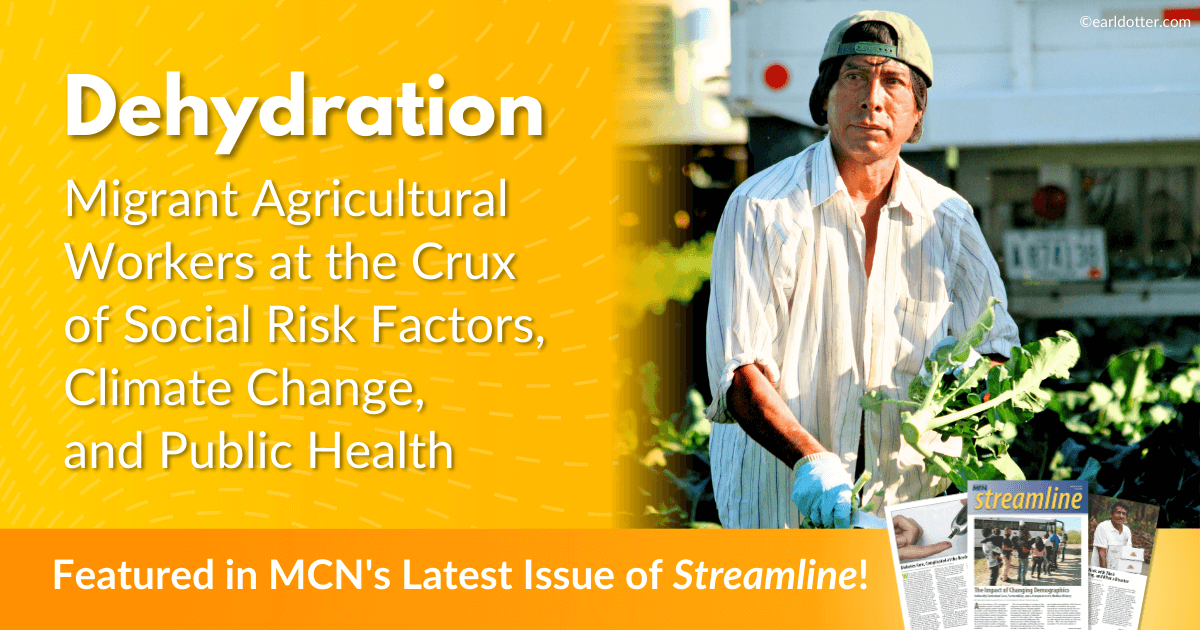Dehydration: Migrant Agricultural Workers at the Crux of Social Risk Factors, Climate Change, and Public Health

[Editor’s Note: An early and severe heat wave hit much of the United States last week. How did agricultural workers handle the heat? New research confirms that agricultural workers are coming to work already dehydrated, making heat that much more dangerous. Here, we reprint a recent article from the most recent issue of our clinical in-print publication, Streamline. You can read the most recent issues or subscribe to receive a copy on our Streamline page. Visit our Heat page to access more resources including archived heat webinars and our Heat-Related Illness Clinician’s Guide.]
Among the estimated 2.4 million farmworkers in the United States, many work temporarily as migrants, seasonal workers, or guest program workers with an H2-A visa. Temporary agricultural workers experience greater mortality and morbidity rates than the general population due to a long list of social risk factors that jeopardize their health while also reducing their access to health care when ill, including but certainly not limited to: food insecurity, cultural and linguistic barriers, immigration status and precarious work authorization, social and geographic isolation, and low literacy and education levels.1 To address these risk factors, community health centers conduct health interventions in their communities based on the research indicating agricultural workers’ health needs. However, these health interventions often do not take into account the ongoing and intensifying effect of climate change on the risk factors that migrant agricultural workers face. In this article, we review recent research on agricultural worker dehydration and overlay this prevalent health concern with climate concerns, concluding with recommendations for community health centers’ health interventions in the climate change era.
Most Farmworkers Come to Work Dehydrated, and Almost All Leave Work Dehydrated
A March 2024 study found that almost 97% of the 111 Florida farmworkers studied were dehydrated at the end of their work shift, with over 62% of farmworkers being dehydrated at the start of their shifts with higher dehydration as the week progressed, indicating possible chronic progressive dehydration.2 The research findings were in line with other studies of farmworker dehydration in Florida. Also reflective of other studies, dehydration was substantially higher among farmworkers than among other types of outdoor workers with heavy workloads. The researchers did not find the dehydration to be associated with the intake of water provided by the employer, farmworkers’ clothing choices, or the amount of crop harvested.
Dehydration is associated with muscle cramps or weakness, headache, fatigue, dizziness, and reduced cardiac function. Impaired internal thermoregulation related to dehydration may increase the risk of heat-related illnesses, the authors added. Further, chronic dehydration is associated with chronic kidney disease of unknown etiology (CKDu), of which there is an epidemic across agricultural worker populations around the world.3 Chronic dehydration is also linked with renal dysfunction, cardiovascular disease, rhabdomyolysis, stroke, and conditions related to oxidative stress. The authors also noted that dehydration “can amplify the negative effects of a heavy workload, making workers more susceptible to fatigue and heat-related illnesses.”
Social factors of agricultural worker dehydration were clearly laid out. In their discussion, the researchers pointed to the working conditions of agricultural workers as not supportive of euhydration (the term for the absence of dehydration or hyperhydration), even when employers follow the field sanitation standard of the Occupational Safety and Health Administration. Long hours, without mandatory rest breaks, piece-rate compensation, fear of losing work in the short- and long-term, the time consumption of staying hydrated, and tenuous immigration status were each called out as elements of agricultural working conditions that disincentivized workers from staying hydrated. The authors stated, “To fully address the issue of acute and chronic health impacts of dehydration and [heat-related illness] among farmworkers, regulatory changes must address living wages and safe working conditions for hired farmworkers along with financial safeguards or cost offsets for owner-operators to sustainably provide them.” The research paper then outlined easier-to-accomplish interventions in the absence of these needed regulatory changes, like proximal clean urination facilities and mobile fans, to mitigate the impact of dehydration.
Dehydration and Climate Change
The researchers concluded that “it is essential to investigate the interaction effects of extreme heat on dehydration in the context of heavy workload,” but do not further delineate why extreme heat is highlighted, nor mention climate change. In reality, the agricultural workers in this study experiencing chronic dehydration are already contending simultaneously with extreme heat.
“In 2023, the world saw the hottest global temperatures in over 100,000 years, and heat records were broken in all continents through 2022,” says The 2023 Report on The Lancet Countdown on Health and Climate Change.4 The 158-page report outlines the extreme health costs of climate inaction to global health and well-being, “yet, adaptation efforts [have] been insufficient to protect people from the growing hazards, and global health inequities are growing,” says the visual summary.5
Community Health Centers at the Forefront
“Health centers seeking to address the health impact of the increasing number of heat days and these dangerous trends in chronic dehydration among agricultural workers need to act fast,” said Amy Liebman, MPA, MA, Chief Programs Officer of Workers, Environment, and Climate at Migrant Clinicians Network. “Climate change is not something that is off in the future. And interventions are needed now to help workers mitigate its impact.”
For example, worker trainings can incorporate the effects of chronic dehydration during an extended extreme heat wave, rather than solely during average or historical summer heat. During heat and dehydration trainings, community health workers can engage agricultural workers on the changing climate and how these hotter, longer heat waves amplify the health risks already at play, so they are better prepared not just for the hot summers of the past, but for the hotter summers of the present and future.
While more research is needed to understand promising practices in communicating climate change impacts to this vulnerable population, some suggestions are:
- Emphasize the urgency of change, at the personal level: In addition to sharing life-saving trainings on how agricultural workers can reduce the risk of dehydration and heat-related illness, share some of the basic information about climate change and how it is impacting your community’s weather already. Agricultural workers need to know that the risks are rapidly increasing, and they will face more extreme weather in the years to come.
- Give pathways for bigger change: When communicating about climate change, it is important to emphasize that climate change is not a zero-sum game. That is, it isn’t “too late” to make changes in behaviors and policies at the family, community, state, and federal levels to reduce greenhouse gases, even though we are already experiencing significant impacts from climate change. The more action taken now, the greater the reductions in the long term.
References
1 Pagán-Santana M, Liebman AK, Seda CH. Deepening the Divide: Health Inequities and Climate Change among Farmworkers. J Agromedicine. 2023;28(1):57-60. doi:10.1080/1059924X.2022.2148034
2 Abasilim C, Friedman LS, Martin MC, et al. Risk factors associated with indicators of dehydration among migrant farmworkers. Environ Res. 2024;251(Pt 2):118633. doi:10.1016/j.envres.2024.118633
3 Hansson E, Mansourian A, Farnaghi M, Petzold M, Jakobsson K. An ecological study of chronic kidney disease in five Mesoamerican countries: associations with crop and heat. BMC Public Health. 2021;21(1):840. Published 2021 May 1. doi:10.1186/s12889-021-10822-9
4 Romanello M, Napoli CD, Green C, et al. The 2023 report of the Lancet Countdown on health and climate change: the imperative for a health-centred response in a world facing irreversible harms. Lancet. 2023;402(10419):2346-2394. doi:10.1016/S0140-6736(23)01859-7
5 Lancet Countdown: Tracking Progress on Health and Climate Change. Accessed 2 May 2024. https://www.lancetcountdown.org/about-us/interact-with-the-key-findings/
- Log in to post comments
